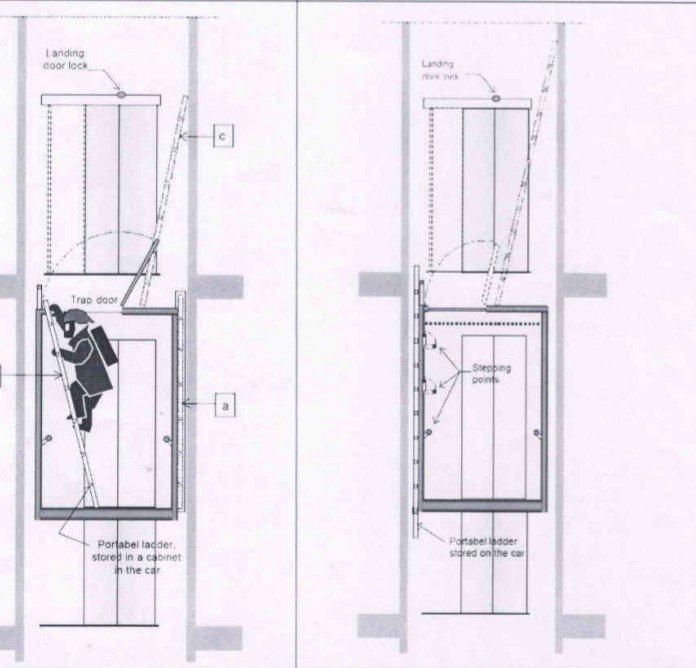
Fire Evacuation Lifts
The increase in fires in high-rise buildings, the difficulties faced by the firefighters in handling the situations, and the loss of lives of firefighters and the building occupants have forced the fire department to work out a foolproof rescue system for the high-rise buildings.
The regular passenger elevator and fire elevator are not able to meet the physical conditions at the fire site. Therefore, some different approaches are worked out to handle high-rise building fires.
This involves an additional lift shaft and elevator with additional features so that the elevator services become helpful during fire rescue operations and maximum passengers/occupants can be rescued in the minimum possible time with minimum loss.
The latest advisory from the Inspector of the lifts office in Maharashtra was issued on 22nd July 2022. for ” Fire Evacuation Lifts for buildings having height 70 meters or above” need to be understood well by the architects, builders, and developers in addition to the elevator suppliers.
The fire evacuation lift is completely different from the passengers and fire lifts and is an additional lift with a separate lift shaft for buildings having a height of 70 meters or above.
The important aspect of the fire evacuation lifts is explained here for the benefit of all the agencies associated with the high-rise building construction.

Aim of FEL –
Introduction of a fire evacuation lift is aimed to ensure that the lift services are available during any building fire and that maximum passengers can be evacuated in the minimum possible time.
A few important features –
1 – It is in addition to regular passenger lifts and fire lifts.
2 – It is compulsory for buildings having a height of 70 meters and above.
3 – The fire evacuation lift should reach the topmost floor from the ground floor in one minute.
4 – The lift cabin, doors, and cables should be fire-resistant for 2 hours.
5 – It should have a separate power supply and the UPS backup for a minimum of 15 minutes of operation.
Important points for the Builders/ architects and construction agencies –
1 – The fire evacuation lift shaft should have minimum internal dimensions of 2300 mm x 2300mm.
2 – All electrical cables should be fire retardant.
3 – Separate source of electricity I. e. DG set should be provided for the fire evacuation lift.
4 – Air pressurization should be provided to maintain air pressurization of not less than 5 mm WG for the lift shaft and 2.5 mm WG for the lift lobby.
6 – Lift landing shall be protected by 2 hrs fire-rated doors/ fire curtain.
7- It should have a mid-landing opening on all the floors.
Important guidelines for elevator suppliers-
1 – Minimum passenger capacity of 15 or 1020 kg. The capacity depends upon the occupancy on each floor, building height, and evacuation time. The capacity and speed should be designed in such a way that it can evacuate a minimum of 100 passengers in 30 minutes.
2 – Elevator cabin, car door, and landing doors should be of 2 hrs. Fire rating.
3 – The Vision panel should be 250 x 250 mm in size and should have 2 hrs fire rating.
4 – An emergency fire evacuation switch should be provided at the ground floor/evacuation floor/lobby floor/podium. 5 – A two-way communication system should be provided in the cabin and one on every floor
6 – Two operating consoles must be provided, one in the car and another on the ground floor, and should be operated through a toggle switch.
7 – The fire evacuation lift should have an IOT (internet of things) control panel which should automatically provide notification to the building security room, register occupant, and nearest fire station in case of any fire.
8 – The fire evacuation lift should have a trap door on the roof of the cabin for emergency evacuation.
9 – A portable/rope-type ladder shall be provided in the cabin for the passengers to come out of the cabin if required.
10 -The landing door panels should have an overlap design so that fire is not transferred through panel joints.
11 – An apron should be provided along the door frame so that fire does not enter into the elevator well.
12 – It should be programmed in such a way that it collects the passengers from the topmost floor first or from the floor where the fire is reported.
Certainly, this is a good move to ensure the availability of elevator services for a maximum period and rescue maximum occupants in the minimum possible time.
This is going to increase the construction cost and maintenance cost of the high-rise buildings, but certainly, it is nothing against the lives of the occupants that could be saved.




